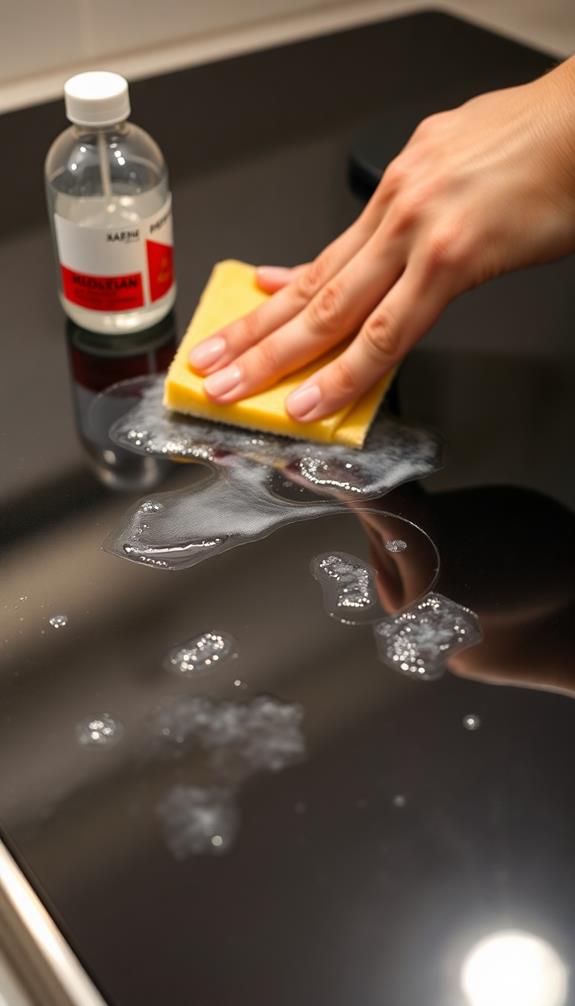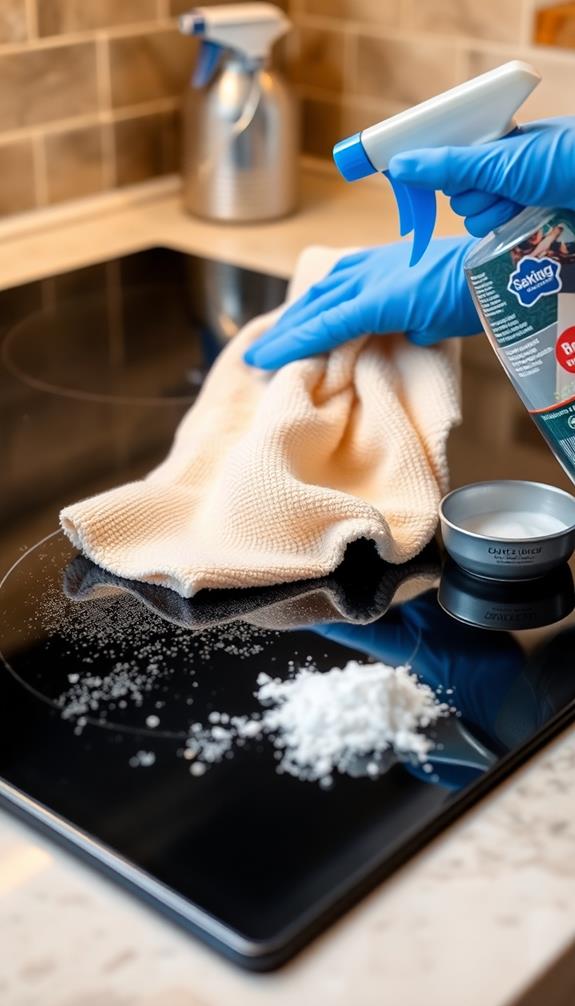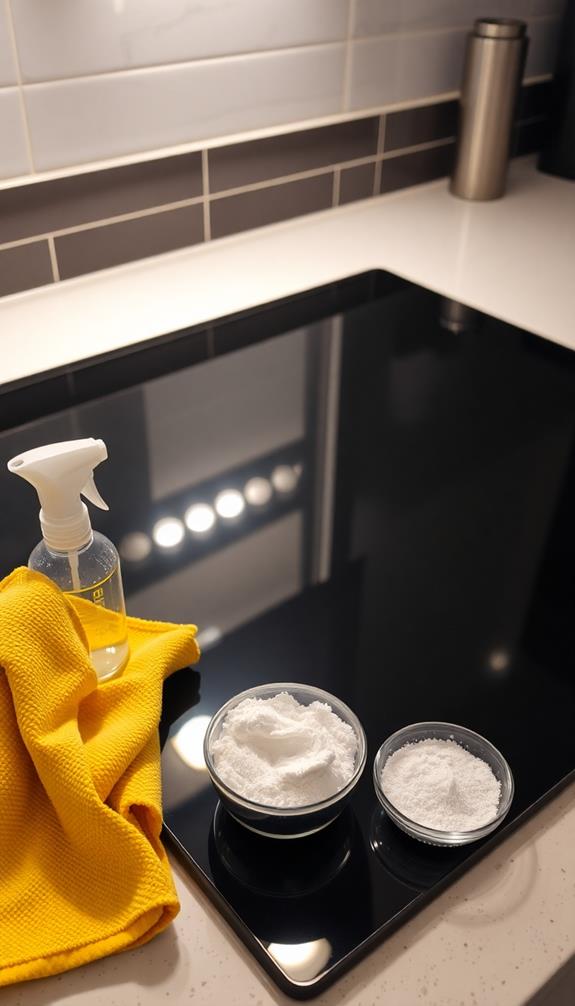To clean your glass cooktop without leaving streaks, start with a cool surface. Mix equal parts distilled white vinegar and water in a spray bottle. Use a non-abrasive cleaning pad to wipe the surface, removing loose debris first. For tough stains, gently scrape them with a single-edge razor blade at a 45-degree angle. Finish by buffing the surface with a dry microfiber cloth for a streak-free shine. Regular maintenance is key, so make it a habit to clean up spills immediately. There's more to discover about keeping your cooktop spotless and shiny!
Materials Needed for Cleaning
When cleaning your glass cooktop, it's vital to have the right materials on hand. Start by gathering non-abrasive cleaning pads to prevent scratching the delicate surface. These pads are perfect for tackling tough stains without damaging your cooktop.
You'll also want to stock up on microfiber cloths, as they're excellent for drying and polishing, ensuring you avoid those pesky streaks. Utilizing eco-friendly ingredients like distilled white vinegar can enhance your cleaning routine while being safe for your family.
Next, make sure you have distilled white vinegar handy. This natural cleaner works wonders on glass stove tops, breaking down grease and grime effectively.
For more stubborn stains, keep some dish soap around; it's a powerful ally when mixed with hot water to create a strong cleaning solution. Speaking of water, having hot water on hand is essential for diluting your cleaning solutions and rinsing surfaces as needed.
Daily and Weekly Cleaning Tips
For a sparkling clean glass cooktop, establish a routine that includes both daily and weekly maintenance. After each use, take a moment to wipe down the glass surface with a damp microfiber cloth. This quick action helps prevent the buildup of food residues and maintain hygiene.
Regularly wiping down kitchen surfaces, especially high-touch areas, guarantees a clean cooking environment and promotes overall kitchen hygiene, as noted in kitchen cleaning steps and techniques.
Incorporate a weekly cleaning routine to keep your cooktop in top shape. Mix equal parts of white vinegar and baking soda to create a powerful cleaning solution. Apply this mixture to the glass surface, allowing it to sit for 10-15 minutes. This will effectively loosen any stubborn stains before you wipe it away with a microfiber cloth.
Always verify the stovetop is completely cool before cleaning to avoid burns and achieve better grime removal. Regularly inspect the glass surface for scratches or damage. If you notice any issues, use non-abrasive cleaning pads to prevent further scratching while cleaning.
Removing Stubborn Stains

When stubborn stains mar your glass cooktop, effective techniques can save the day.
Mixing baking soda with white vinegar creates a powerful bubbling action that helps lift grime, similar to the Vinegar and Water Solution Method.
For tougher burn marks, a little dish soap and a scrubber can make a big difference.
Effective Stain Removal Techniques
Stubborn stains on glass cooktops can be a real headache, but with the right techniques, you can tackle them head-on. For burnt-on food, start by mixing dish soap with a scrubber, applying it in circular motions to lift those tough marks.
If that doesn't do the trick, grab some baking soda and white vinegar. Spray the vinegar on the stained area, sprinkle baking soda over it, cover with a hot towel, and let it sit for up to 15 minutes. This powerful cleaning reaction will help loosen the stain.
For really stubborn spots, a single-edge razor blade can be your best friend. Hold it at a 45-degree angle to carefully scrape away tough residues without scratching your glass stove. Regularly scraping the stovetop keeps gunk buildup at bay and maintains a clearer surface.
After using any cleaning method, always follow up with a damp microfiber cloth to wipe away grime and guarantee a streak-free finish.
Baking Soda and Vinegar
Sometimes, tough stains on glass cooktops require a little extra effort, and that's where baking soda and vinegar come in. Start by spraying the surface with white vinegar; its acidity works wonders for breaking down grease and grime.
Once you've coated the area, sprinkle baking soda over the vinegar. This combination creates a bubbling reaction that helps lift stubborn food residue.
Let the vinegar and baking soda mixture sit for about 10-15 minutes to maximize its effectiveness on those tough stains. For even better results, grab a hot, damp towel and cover the mixture during this waiting period. The heat will further soften the grime, making it easier to clean.
When the time's up, take a microfiber cloth and wipe the surface clean. The cloth will help you achieve a streak-free finish, leaving your glass cooktop looking immaculate.
This simple yet effective method utilizing baking soda and vinegar is your go-to solution for tackling stubborn stains. With a little patience and the right technique, you'll have your cooktop sparkling in no time!
Recommended Cleaners and Solutions
Cleaning your glass cooktop doesn't have to be a hassle, and knowing which cleaners to use can make all the difference. For everyday cleaning, dish soap is a versatile and effective option. It tackles both light grime and tougher stains well, especially when paired with a non-abrasive sponge.
Additionally, using non-toxic cleaning solutions guarantees that your kitchen remains safe for your family while maintaining cleanliness. If you're looking for something more potent, consider popular commercial cleaners like Bar Keepers Friend or Mr. Clean MagicEraser. These are formulated specifically to avoid scratching while effectively removing dirt.
For a more natural approach, mix baking soda with distilled white vinegar. Apply the vinegar, sprinkle the baking soda, and let it sit under a hot towel for enhanced cleaning.
You can also create a DIY glass cleaner by combining one part distilled vinegar with three parts distilled water. This solution not only cleans but helps achieve a streak-free finish.
If you want to add a pleasant scent to your cleaning routine, consider incorporating essential oils into your DIY cleaning solutions. This way, you can maintain a fresh aroma without using harsh chemicals that could damage your cooktop.
Cleaning Do's and Don'ts

When cleaning your glass cooktop, always opt for non-abrasive cleaning products and microfiber cloths to keep it scratch-free.
You should avoid harsh chemicals and abrasive materials that could damage the surface.
Safe Cleaning Products
To keep your glass cooktop in pristine condition, it's essential to choose the right cleaning products. Always opt for safe cleaning products specifically designed for glass stovetops to avoid scratching and damaging the surface.
When you clean your glass stove, steer clear of ammonia-based cleaners like Windex, as they can cause discoloration and harm the glass. Instead, consider using natural DIY cleaners—distilled white vinegar and baking soda are effective and safe alternatives that won't jeopardize the integrity of your cooktop.
Make it a habit to regularly check the manufacturer's guidelines for recommended cleaning products. This guarantees you're using options that maintain the longevity of your glass cooktop.
When cleaning your glass, avoid using abrasive materials, including steel wool, as they can create micro-scratches that accumulate dirt and grime over time.
Avoid Abrasive Materials
It's crucial to avoid abrasive materials when maintaining your glass cooktop. Using steel wool or any abrasive scrubbers can scratch and damage the glass surface, making it harder to clean glass without leaving streaks. Instead, opt for non-abrasive cleaning pads or microfiber cloths, which effectively lift grime while protecting the integrity of your cooktop.
Steer clear of harsh chemicals that aren't specifically formulated for glass stovetops, as these can etch or discolor the surface. For simple cleaning, use a gentle cleaner that's safe for glass.
Additionally, be mindful of how you handle pots and pans; dragging them across the cooktop can create micro-scratches that compromise its appearance over time.
Regularly inspect your stovetop for any existing scratches or damage. This awareness can help you adjust your cleaning approach and choose suitable products, ensuring you maintain a pristine look.
Best Practices for Streak-Free Finish
Achieving a streak-free finish on your glass cooktop is easier than you might think. First, confirm the surface has cooled down completely before you start cleaning. This not only prevents burns but also helps effectively remove grime, as regular disinfection reduces the risk of foodborne illnesses.
For a cost-effective and streak-free cleaner, mix 1 part distilled white vinegar with 3 parts distilled water in a spray bottle.
Before applying your cleaner, turn off all lights above the stove to avoid any heat that might cause streaking. Spray the solution onto the glass surface, and then take a non-abrasive cleaning pad or a microfiber cloth to wipe it down. This step is essential as it guarantees thorough cleaning without scratching or leaving residue behind.
After you've wiped the surface clean, grab a dry microfiber cloth for the final polish. Buff the surface gently, which enhances shine and eliminates any remaining streaks.
Importance of Regular Maintenance

Maintaining a clean glass cooktop goes beyond achieving a streak-free finish; regular upkeep is vital for its longevity and performance. By incorporating daily cleaning habits, you can prevent the buildup of food residues and grease that often lead to stubborn stains.
Every time you cook, make it a point to wipe down your glass immediately afterward. This simple action reduces the risk of baked-on messes and makes future cleanings quicker and easier.
Additionally, essential steps for deep cleaning your kitchen can provide a thorough approach to maintaining a spotless cooking environment. Establishing a routine of weekly deep cleaning will help maintain your cooktop's shine and prevent the formation of hot spots that could lead to cracking.
Consistent maintenance not only keeps your stove looking great but also extends its lifespan by preventing scratches and damage. Regularly inspect your glass surface for any signs of wear; addressing these minor issues promptly can guarantee a safer cooking environment.
Step-by-Step Cleaning Process
Cleaning your glass cooktop effectively requires a straightforward approach to guarantee it remains in top condition. Follow these steps for a thorough cleaning that leaves your glass stovetop streak-free:
- Cool Down: Make certain the cooktop is completely cool before you start cleaning to avoid burns or damage.
- Remove Debris: Wipe the surface with a non-abrasive cleaning pad to eliminate loose debris and dirt. This prepares the surface for deeper cleaning.
- Vinegar Solution: Mix equal parts distilled white vinegar and water in a spray bottle. Vinegar not only cleans but also acts as a natural fabric softener for various surfaces, enhancing your cleaning routine. Spray the solution evenly across the stovetop for effective cleaning.
- Final Wipe: Using a damp microfiber cloth, wipe down the glass stovetop to remove all residue from the vinegar solution. Confirm you're thorough to achieve that streak-free finish.
If you encounter stubborn residues, carefully use a single-edge razor blade at a 45-degree angle to scrape off burnt food without scratching the surface.
This step, combined with the vinegar solution, will keep your glass cooktop looking pristine and ready for your next culinary adventure.
Conclusion
By keeping your glass cooktop clean, you're not just maintaining its shine; you're nurturing the heart of your kitchen. A sparkling surface reflects your commitment to a welcoming home, just like a clear sky promises a bright day ahead. Embrace regular cleaning as your daily ritual, and soon, those streaks will vanish like clouds on a sunny morning. With the right tools and techniques, you'll transform your cooktop into a gleaming canvas ready for culinary masterpieces.